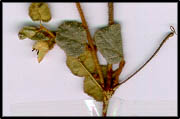South West Slopes Revegetation Guide
Correa reflexa var reflexa
Common Correa
Select from the following for detailed images.
Species Information
| Synonyms |
|
| Common Names |
Common Correa, Native Fuchsia, Fuschia. |
| Family |
Rutaceae - Rue family. |
| Name Origin |
Correa - after Portuguese scholar and botanist Jose Francesco Correia da Serra (1750-1823). reflexa - from Latin reflectere, to bend back, referring to corolla (petals). glabra - from Latin glaber, without hair. |
Specimen Data - CSU 2769
| Location |
Table Top Mountain, NSW. |
| Notes |
identified by the National Herbarium Sydney. |
| Collector |
Stelling, F. |
Date |
01/09/1997 |
| Determined By |
Unknown |
Date |
01/12/1997 |
South West Slopes Revegetation Guide Information
| Regional: |
Noted in the areas: Albury; Bowna-Jindera; Yambla; Rosewood Plateau; Maragle; Ardenside-Welaregang; O'Briens South & McLeods and Burkes & Graveyard. Probably occurs in areas adjacent to those noted, in similar country. |
| Australia: |
Noted in the areas: Albury; Bowna-Jindera; Yambla; Rosewood Plateau; Maragle; Ardenside-Welaregang; O'Briens South & McLeods and Burkes & Graveyard. Probably occurs in areas adjacent to those noted, in similar country. |
| Habitat: |
Dry sclerophyll forest and heath, usually on sandstone or coastal dunes. |
| Habit: |
Spreading or erect shrub, 50 cm to 1.5 m high. Round dull green leaves with pale undersides. |
| Similar Species: |
|
| Site Preference: |
|
| Characteristics: |
|
| Flowering: |
Green or red and green, Apr-Sep. Bell-shaped. Generally flowers for long period before other spring flowers. |
| Seed Collection: |
Early Nov to late Feb. Monitor closely as seeds released immediately or within 1-2 days of maturity. |
| Propagation: |
From cuttings, which strike readily, or from seed. Take cuttings with heels in autumn or spring and treat with hormones to improve strike rate. Most sources recommend leaching seeds for several weeks, however some growers indicate seeds germinate readily without treatment. Best results when sown at warmer temperatures. |
| Regeneration: |
From rootstock after fire. |
| Timber: |
|
| Shade and Shelter: |
|
| Land Protection: |
|
| Wildlife: |
Good habitat. Nectar a food source for honeyeaters including the Eastern Spinebill, Yellow-faced Honeyeater, White-naped Honeyeater and New Holland Honeyeater. Seed a food for various native birds. |
| Ornamental: |
Excellent for dry shady sites and containers and under mature trees. Interesting foliage. Prune lightly to encourage flowering and bushy growth. Water regularly and thoroughly during growing period to encourage flowering. Resents moisture fluctuations. |
| Other: |
Cut flowers. |
Note: The following information presented is only a guide, as plant characteristics vary depending on provenance (the plant's locality).
| Site/Preferred Habitat : |
well-drained soils |
| Rainfall(mm) : |
500 |
| Growth Rate : |
moderate |
| Tolerates : |
full sun; dry soils; frost |
| Resents : |
poor-drainage |
| Uses & Comments : |
wildlife; ornamental; cut flowers |
Return to Database List
